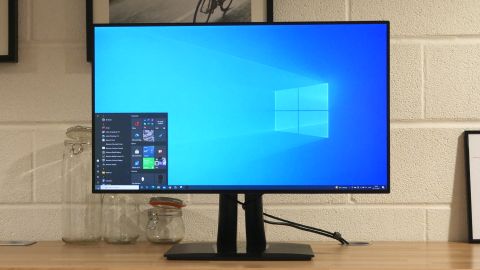TechRadar Verdict
An upgrade to USB-C connectivity for Viewsonic’s 4K 32-inch productivity panel delivers a compelling value proposition
Pros
- +
Great overall productivity feature set
- +
Good factory calibration
- +
Competitive pricing
Cons
- -
No HDR support
- -
Dated styling
Why you can trust TechRadar
Do not adjust your PC, smartphone, tablet or Mac, you have indeed seen the Viewsonic VP3268a-4K before. At least, you’ve seen a display that looks just like it in the Viewsonic VP3268-4K. But that small tweak in nomenclature translates into some pretty significant hardware upgrades.
The basic proposition remains the same, namely a 32-inch 4K monitor based on a quality, factory-calibrated IPS panel and aimed at productivity and content creation. This isn’t a full-on professional grade panel, that kind of display costs far more. But it does promise significant color-relevant features for the price point.

As for what’s new with the Viewsonic VP3268a-4K over the old non “a” model, the most obvious change is the addition of USB Type-C connectivity complete with power delivery of up to 90 watts. That’s a huge upgrade when it comes to usability and flexibility, enabling single-cable connectivity and docking capabilities including ethernet support.
The other big change is the addition of Pantone validation and a small uptick in color accuracy. That combination adds to the Viewsonic VP3268a-4K’s proposition as a content creation monitor. Overall, it’s a promising package for getting serious work done.
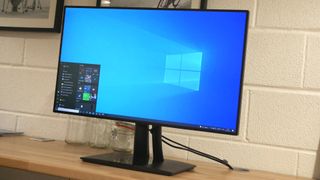
Price and availability
The combination of 4K, IPS and USB-C docking doesn’t come cheap. At $899 in the US and £829, the Viewsonic VP3268a-4K is very much at the lower end of the pricing scale for this class of monitor, but more expensive than some 32-inch 4K monitors with USB-C connectivity.
Screens like the BenQ SW321C cost way more and even Asus’s entry Pro Art 32-inch panel, the PA329C, is a bit more costly. The Philips Brilliance 329P9H is close on price and spec, but lacks some of the Viewsonic VP3268a-4K’s content-creation chops, including Pantone validation and a factory calibration report.

Design and features
The Viewsonic VP3268a-4K’s physical design is familiar and, if anything, underwhelming. Slim bezels aside, the chassis looks a little dated. However, it’s both well built and well featured, offering a full range of adjustability, which is arguably what matters more in the long term.
The panel at the heart of the VP3268a-4K is an up-to-date 4K, 32-inch item based on IPS technology. With a 1,300:1 contrast ratio, it only falls short in that regard compared to the very latest IPS technology that has recently emerged offering up to 2,000:1 native contrast.
However, this is a productivity panel that lacks HDR support. So, contrast performance isn’t high on the list of priorities. What is important is color accuracy, hence features like Pantone Validation.
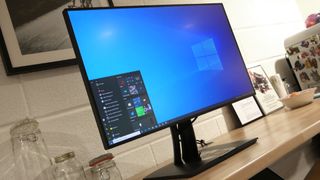
It’s worth noting that Pantone Validation doesn’t actually imply outstanding display accuracy in a conventional sense. It’s a system with its origins in print and color swatches. It’s a reflective model of color and so inherently smaller than the emission-based color gamuts that prevail for screens. Long story short, the standard being tested for Pantone Validation is actually less demanding than sRGB let alone higher fidelity gamuts like DCI-P3. It’s not hugely relevant for creating digital content like video and images, but of more use for workflows that involve printing.
Still, the Viewsonic VP3268a-4K has plenty more to offer when it comes to color. For starters, it comes factory calibrated with Delta E values below two across the board. Then there’s the 14-bit 3D look-up table, plus ViewSonic’s Colorbration+ hardware calibration engine, which supports a wide range of calibration tools.

Panel size 32-inch
Panel type IPS
Resolution 3,840 x 2,160
Brightness 300cd/m2
Contrast 1,300:1
Pixel response 5ms
color coverage 113% sRGB
Refresh rate 60Hz
Vesa 100mm x 100mm
Inputs DisplayPort 1.4, HDMI 2.0 x2, USB-C with 90W PD
The other major highlight is USB Type-C connectivity. That provides the usual support for video, data and power delivery via a single cable, which is one of those features you never want to live without once you’ve tried it, especially if a laptop is your primary PC or Mac.
Elevating the VP3268a-4K slightly above other USB-C displays is support for up to 90W of power delivery (some of the competition tops out at 60W or even less), plus an ethernet port for networking passthrough and thus full dock functionality.

Performance
Given the factory calibration, you’d expect the Viewsonic VP3268a-4K to look great right out of the box. And that’s exactly what it does. The default calibration is gorgeous, somehow vibrant and saturated at the same time as balanced and natural. There’s absolutely no sign of compression in test images.
That said, the range of color space presets is a little narrow. Neither DCI-P3 nor Adobe RGB feature, for instance. Also registering on the less impressive side of the tally is the pixel response, which is poor in the factory setting. The OSD menu does include overdrive settings with which to tweak the response. But even the fastest option delivers mediocre response. Still, at least overshoot isn’t an issue and, given the productivity remit of the VP3268a-4K, this isn’t a major deal breaker.
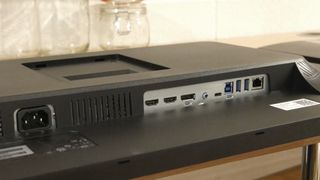
This panel is also a nice fit whether you’re using Windows or MacOS. The latter is rather sensitive to pixel density when it comes to font rendering. 4K over 32 inches arguably isn’t quite the stuff of true high-DPI computing. But it is enough for pretty crisp fonts in MacOS and indeed Windows. Regarding the latter, the generous panel size means that it will be viable for some users to run at 100 percent scaling, which is handy given Windows still doesn’t deliver a consistent experience when using anything but the 100 percent setting.
Verdict
In this age of HDR everything, the Viewsonic VP3268a-4K looks a little dated both on paper and on your desk in design terms. It’s a pure SDR panel with no HDR pretensions and slightly old fashioned styling.
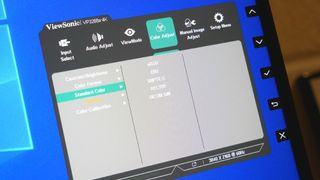
The reality, of course, is that most so-called HDR monitors are nothing of the sort. Unless you specifically need HDR support for your workflows, its omission is of little consequence here. Instead, what matters is the strong productivity feature set.
Granted, the Pantone Validation is arguably a niche concern that won’t deliver tangible benefits to most users. But the Viewsonic VP3268a-4K certainly has plenty going for it for serious workflows, including factory calibration and hardware calibration support.
Finally, the USB-C connectivity with ethernet passthrough and 90W power delivery is a huge productivity boon. That you get all this for a competitive price makes for a very attractive overall proposition. Offering great value has always been a hallmark of Viewsonic displays. The Viewsonic VP3268a-4K is happily no exception.
We've featured the best business monitors.
Technology and cars. Increasingly the twain shall meet. Which is handy, because Jeremy (Twitter) is addicted to both. Long-time tech journalist, former editor of iCar magazine and incumbent car guru for T3 magazine, Jeremy reckons in-car technology is about to go thermonuclear. No, not exploding cars. That would be silly. And dangerous. But rather an explosive period of unprecedented innovation. Enjoy the ride.
